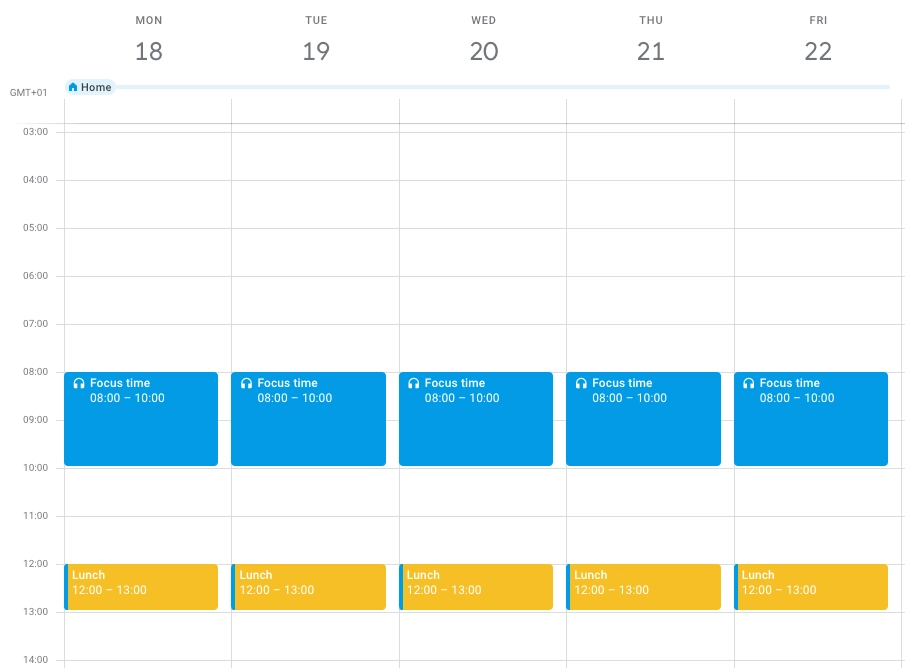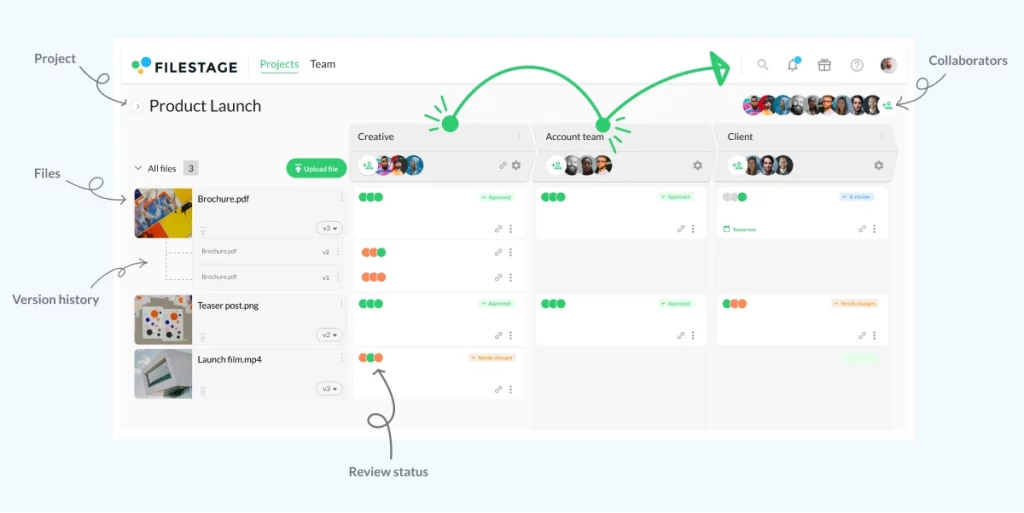It’s estimated that around three in ten people in the US now work exclusively remotely. And with so many benefits, from cutting childcare costs to steering clear of rush hour traffic, it’s easy to see the appeal.
But while remote work offers more freedom and flexibility, it can also create some extra challenges when it comes to creating an effective workflow and having a healthy balance between work and life. When your home also doubles as your office, the boundaries can quickly become blurred between your professional and personal life. Which can leave you feeling overworked and overwhelmed. Yikes!
But the good news is with a few new habits and some top remote work software to hand, you can enjoy all the perks of working from home without letting it leak into the rest of your life.
In this article, I’m going to share nine remote work tips to help you nail your work-life balance. But before that, let’s look at what we mean when we talk about work-life balance in relation to remote work.
What is work-life balance?
Work-life balance is all about finding that sweet spot between succeeding in your professional role and managing your personal life. This involves making sure you have enough time to do your job well, while also spending time with family, doing activities you enjoy, and taking care of your physical and mental health.
Too often, remote employees make the mistake of seeing work-life balance as a luxury. But the reality is, if you don’t find the balance between work and life in your remote position, it can have a real impact on your overall well being.
Here are some of the most common things that get in the way of work-life balance when working remotely:
- Constant connectivity – Working from home usually means you’re accessible via email, team communication tools, or video calls all day, every day. This can make it harder to create and keep healthy boundaries.
- Tight deadlines – Of course, time pressure impacts us whether we’re working from home or not. But the blurring of boundaries means that many remote workers have to deal with an increased expectation to work long into the night or over the weekend to get a job done in time.
- Reduced physical activity – When your office is in your home, it can be easier to slip into a more sedentary lifestyle without regular fresh air and exercise. This can negatively impact your physical, emotional, and mental health.
- Lack of routine – Without a structured office environment, remote workers can struggle to maintain a consistent work schedule. This leads to irregular working hours and an irregular schedule outside of work too.
1. Set and stick to a schedule
While flexibility is one of the biggest benefits for many remote workers, too much of a good thing can actually hinder your work-life balance. That’s why it’s important to give structure to your days by maintaining regular work hours throughout the week.
Ivona Mikulčić, our Senior Product Marketing Manager here at Filestage, has shared her approach for finding a balance between structure and flexibility when working from home.
“Despite the fact that we work remotely and have flexible hours, I still prefer having a routine to keep my work hours organized so my advice would be to discover the best routine that suits you and your lifestyle. While I may need to adjust my working hours or the place I work from on some days, I still prefer my own desk in my apartment. But the most important thing to me is that it’s my own routine and schedule that I control.”
As well as defining your normal working hours, it’s also a good idea to think about the type of tasks you do at different times of the week or day. For example, if you’re at your most focused in the mornings, this could be a good time to get stuck into the creative process, or vice versa. Not everyone is at their most productive at the same time, so find what works best for you.

2. Have a dedicated workspace
Another great thing about working remotely is that you get to choose where you work. But with this extra freedom comes a responsibility to choose wisely.
I’d be lying if I said I haven’t worked from the sofa on a few occasions, but I really would not recommend making a habit of it. Instead, work on creating a clearly defined workplace, as this will help set you up for a more productive and fulfilling professional life. Sometimes, it can be nice to work from co-working spaces or a local coffee shop for a change of scene. But the structure of a dedicated office space will help your routine overall.
While a dedicated desk is definitely a start when it comes to establishing your remote workspace, an entirely separate room will make it easier to switch out of work mode when your day is done.

3. Communicate with your team
Remote communication is absolutely crucial for minimizing stress and enjoying a more balanced and fulfilling remote work experience.
Effective remote communication has a few different roles in a remote work environment. For starters, once you establish your work schedule, it’s important to make your team aware of when they can reach you by video call and the best times to schedule virtual meetings. Of course, this works the other way around too, so make sure you also know and respect the schedules of other remote workers in your team.
As well as setting boundaries, effective communication helps align your team members’ efforts with overarching objectives and organizational priorities.
By keeping everyone on the same page regarding progress, timelines, and achievements, businesses can foster a greater sense of purpose, as well as seamless coordination and collaboration across projects. This helps everyone use their time efficiently to get the job done as planned.
4. Choose the right collaboration tools
Lackluster collaboration within and between remote teams make it virtually impossible to run a smooth and successful business. Which can have a serious knock-on effect on your teammates’ remote work life.
Luckily, there’s a wide range of collaboration tools and project management software that can help streamline the way your team works together for less stress and more productivity across the board. These team productivity tools will make it easier to drive results and stay connected.
From top file sharing software to the most reliable hybrid work tools, it’s important to assess your business’ needs so you can pick the best tools to help you get the job done without any unwanted hiccups.
Collaboration tools play a vital role in promoting work-life balance for remote workers by improving communication and managing everyone’s time effectively to help fend off any nasty scheduling surprises.
5. Establish a solid review and approval workflow
Nothing ruins work-life balance like chasing and organizing feedback on your projects. Without a reliable review and approval workflow in place, remote collaboration can turn into a chaotic and time consuming process.
That’s where a review and approval tool like Filestage becomes invaluable.
Filestage is designed to streamline the way teams review and approve work by giving them one user-friendly space to share files, provide feedback, and make review decisions.

Because it can be used to review a range of file formats (documents, designs, videos, PDFs, live websites, and more), Filestage makes it easy to manage all your projects for faster approvals and better work-life balance.
Pretty nice, right?
Here’s how to set up a review and approval workflow in six steps
- Sign up to Filestage for free
- Upload your files and add a due date
- Invite your reviewers or send them a link (they don’t need an account)
- Let reviewers add their feedback and discuss ideas in the comments
- Turn the comments into a to-do list so you can tick off edits for the next version
- Upload the new version to Filestage
Supercharge your remote collaboration
Share, review, and approve all your content in one place with Filestage.
6. Take regular breaks
In a traditional office setting, it’s common to take regular coffee breaks, water breaks, and other short pauses throughout the day. But as a remote worker, it’s easier to lose track of time and continue working without taking a moment to reset. This can have a negative impact on your productivity in the long run.
Here are some simple ways to help you press pause throughout the day:
- Set an alarm every couple of hours that reminds you to move about and get some natural light, maybe with some stretches or a short walk around the block.
- Take short breaks between meetings to make a quick snack or a cup of tea.
- Keep a glass or bottle of water on your desk so you remember to take a few minutes every now and then to stay hydrated.
And if you’re looking for some more inspiration, our Senior SEO & Content Manager, Muriel Skusa, has shared her favorite way to recharge her batteries when working remotely.
“I think it’s important to structure your day and take breaks. I really like to go on nature walks during my lunch break.”
By incorporating regular breaks into your remote work routine, you’ll be able to boost your productivity and creativity.

7. Limit distractions
There’s a difference between taking regular breaks and wasting time during work hours. If you’re always dropping the ball to do something at home, you’re going to end up chasing your tail to stay on top of your workload. This is why it’s important to set ground rules for yourself to get the most out of your remote environment.
How to minimize distractions when working remotely
Any good office environment will allow you to focus on the task at hand, and this applies to your home office too.
Let’s look at some things you can do to keep distractions at bay.
- Silence notifications – Constant notifications from emails, messages, and social media can disrupt your workflow and derail concentration. That’s why it’s a good idea to consider silencing non-essential notifications during work hours or putting yourself on “Do Not Disturb” mode to block out any interruptions.
- Set boundaries with family members – Make sure your family members or housemates are aware of your work schedule and the importance of minimizing interruptions during designated work hours. This will help create a more productive work environment so you can give your loved ones the time they deserve outside of work.
- Set tasks and time limits – One thing that helps me stay focused throughout the day is giving myself a fixed amount of time to get a certain task or amount of work done. Breaking my task list down into manageable chunks and short-term goals creates an extra motivation that helps me stay in the zone for maximum productivity. After every focus session, I’ll reward myself with ten minutes outdoors, a quick snack, or a scroll on social media. If you haven’t tried this tactic, definitely give it a go!
8. Stay active
When your office is just a few feet from your bed or your sofa, it can be all too easy to miss out on the movement your body needs. When you’re working remotely, regular exercise is essential to stay in tip-top physical and mental shape, as well as boost productivity.
This is not to say you need to go to the gym six days a week if you work from home. But by simply integrating some form of physical activity into your day, you’ll be able to keep your body and mind feeling good.
Staying active could be as simple as incorporating a walk into your morning routine, or doing 15 minutes of yoga between meetings. Even running errands on your lunch break will help you get some steps in and some extra vitamin D. Find an activity or an exercise schedule that you enjoy and build it into your remote working routine.

9. Switch off
All the remote work tips in the world won’t help you find a great work-life balance if you’re accessible 24/7 and working around the clock.
While it can be tempting to work late when you technically have the time, this is a one-way ticket to burnout. It’s important to respect your own boundaries when working late instead of striving for perfection every single day.
At the end of your working hours, close down your professional apps, step away from your computer screen, and spend some time on the things in your life that matter most.
Final thoughts
Separating your work and personal life can be challenging, especially when working remotely. But hopefully this article has given you all the tips you need to be more efficient and find the perfect remote working routine for you.
If you’d like to see how Filestage can take your remote workflow to the next level, start your free trial today.









